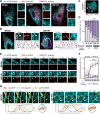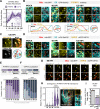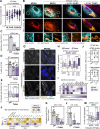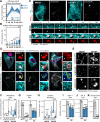Restructured membrane contacts rewire organelles for human cytomegalovirus infection
- PMID: 35953480
- PMCID: PMC9366835
- DOI: 10.1038/s41467-022-32488-6
Restructured membrane contacts rewire organelles for human cytomegalovirus infection
Abstract
Membrane contact sites (MCSs) link organelles to coordinate cellular functions across space and time. Although viruses remodel organelles for their replication cycles, MCSs remain largely unexplored during infections. Here, we design a targeted proteomics platform for measuring MCS proteins at all organelles simultaneously and define functional virus-driven MCS alterations by the ancient beta-herpesvirus human cytomegalovirus (HCMV). Integration with super-resolution microscopy and comparisons to herpes simplex virus (HSV-1), Influenza A, and beta-coronavirus HCoV-OC43 infections reveals time-sensitive contact regulation that allows switching anti- to pro-viral organelle functions. We uncover a stabilized mitochondria-ER encapsulation structure (MENC). As HCMV infection progresses, MENCs become the predominant mitochondria-ER contact phenotype and sequentially recruit the tethering partners VAP-B and PTPIP51, supporting virus production. However, premature ER-mitochondria tethering activates STING and interferon response, priming cells against infection. At peroxisomes, ACBD5-mediated ER contacts balance peroxisome proliferation versus membrane expansion, with ACBD5 impacting the titers of each virus tested.
© 2022. The Author(s).
Conflict of interest statement
The authors declare no competing interests.
Figures






Similar articles
-
Infection-Induced Peroxisome Biogenesis Is a Metabolic Strategy for Herpesvirus Replication.Cell Host Microbe. 2018 Oct 10;24(4):526-541.e7. doi: 10.1016/j.chom.2018.09.002. Epub 2018 Sep 27. Cell Host Microbe. 2018. PMID: 30269970 Free PMC article.
-
Intracellular redistribution of neuronal peroxisomes in response to ACBD5 expression.PLoS One. 2018 Dec 27;13(12):e0209507. doi: 10.1371/journal.pone.0209507. eCollection 2018. PLoS One. 2018. PMID: 30589881 Free PMC article.
-
Viral DNA Sensors IFI16 and Cyclic GMP-AMP Synthase Possess Distinct Functions in Regulating Viral Gene Expression, Immune Defenses, and Apoptotic Responses during Herpesvirus Infection.mBio. 2016 Nov 15;7(6):e01553-16. doi: 10.1128/mBio.01553-16. mBio. 2016. PMID: 27935834 Free PMC article.
-
The Roles of Host and Viral Antibody Fc Receptors in Herpes Simplex Virus (HSV) and Human Cytomegalovirus (HCMV) Infections and Immunity.Front Immunol. 2019 Sep 6;10:2110. doi: 10.3389/fimmu.2019.02110. eCollection 2019. Front Immunol. 2019. PMID: 31555298 Free PMC article. Review.
-
Staying in Healthy Contact: How Peroxisomes Interact with Other Cell Organelles.Trends Mol Med. 2020 Feb;26(2):201-214. doi: 10.1016/j.molmed.2019.09.012. Epub 2019 Nov 11. Trends Mol Med. 2020. PMID: 31727543 Review.
Cited by
-
The Addis Ababa Lions: Whole-Genome Sequencing of a Rare and Precious Population.Genome Biol Evol. 2024 Feb 1;16(2):evae021. doi: 10.1093/gbe/evae021. Genome Biol Evol. 2024. PMID: 38302110 Free PMC article.
-
Intercellular communication within the virus microenvironment affects the susceptibility of cells to secondary viral infections.Sci Adv. 2023 May 10;9(19):eadg3433. doi: 10.1126/sciadv.adg3433. Epub 2023 May 10. Sci Adv. 2023. PMID: 37163594 Free PMC article.
-
The novel bacterial effector protein CbEPF1 mediates ER-LD membrane contacts to regulate host lipid droplet metabolism.bioRxiv [Preprint]. 2023 Dec 11:2023.12.11.571031. doi: 10.1101/2023.12.11.571031. bioRxiv. 2023. Update in: EMBO Rep. 2024 Dec;25(12):5331-5351. doi: 10.1038/s44319-024-00266-8. PMID: 38168204 Free PMC article. Updated. Preprint.
-
Rickettsia parkeri forms extensive, stable contacts with the rough endoplasmic reticulum.J Cell Biol. 2025 Mar 3;224(3):e202406122. doi: 10.1083/jcb.202406122. Epub 2025 Jan 7. J Cell Biol. 2025. PMID: 39775737
-
DNA-PK and ATM drive phosphorylation signatures that antagonistically regulate cytokine responses to herpesvirus infection or DNA damage.Cell Syst. 2024 Apr 17;15(4):339-361.e8. doi: 10.1016/j.cels.2024.03.003. Epub 2024 Apr 8. Cell Syst. 2024. PMID: 38593799 Free PMC article.

